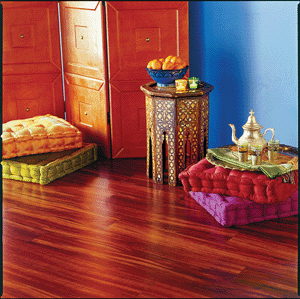 |
Pergo’s World Traveler collection generate greater profits
and happier customers. |
|
By Matthew Spieler
During tough economic times many inspirational sayings are created to help motivate retailers and their salespeople. One particular one, though, is poignant for this story: “During good times, the Mercades Benz dealer knows he will sell ‘x’ amount of cars each month, and during bad times, he knows he will sell ‘x’ amount of cars.”
The point is, at the upper end of the market, sales are not only predictable, they move steadily up regardless of the economic situation. The reason? Those with disposable cash still have it when the economy slides and they still like to spend it. Even during the Great Depression, the upper class continued to make purchases—and they didn’t skimp when doing so.
“The people who have the money have not necessarily been impacted by the current issues—gasoline and war—financially, so they continue to spend,” said
Tim Tipton, of
Formica Flooring, who at press time was promoted to director of marketing and product development.
Manufacturers will point out focusing on the better products not only allows retailers to maintain a steady sales volume, they actually help grow profits compared to the lower-end goods.
“High-end products can be very advantageous for both the retailer and the consumer,” explained
David Small, marketing director for
Pergo. “For the retailer, they generate a significant percentage of profits due to higher margin structure; for the consumer, they provide the latest product innovations and technologies, assuring the best floor possible. Additionally, higher-end products are supported by manufacturers with the longest and most inclusive warranties.”
Al Boulogne, Mannington’s laminate product manager, noted how dealers can put more money in their pockets selling better goods. “The margin dollars that come from the high-end are so much greater.” It’s simple, 40% on $1.99 compared to 40% on a $3.99 product gives you twice the money on the same amount of footage.
Milton Goodwin, Armstrong’s general manager of laminate and ceramic products, explained, “The average floor sale is 250 square feet, so a $2 difference per foot is $500.” He added, dealers actually earn more at the upper levels compared to cheaper goods because margin percentages are greater. “On the lower side margins are 10% to 25%, whereas at the mid to high price points they are 25% to 50%.
“Plus,” he added, “you get a satisfied customer for life and that leads to other sales from her, and her neighbors and friends who see a great looking floor and want one for their homes.”
“Absolutely,” agreed Tipton. “Aside from features and benefits—aesthetics—the thicker and more stable the product obviously the less claims. It’s a shame when a retailer thinks he makes the money on the buy versus knowing that you actually make it on the sell and a satisfied customer.”